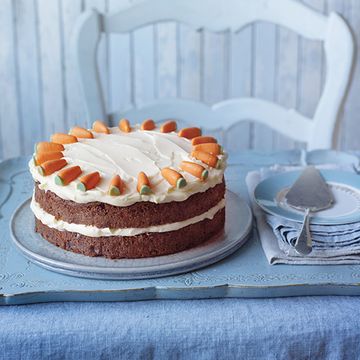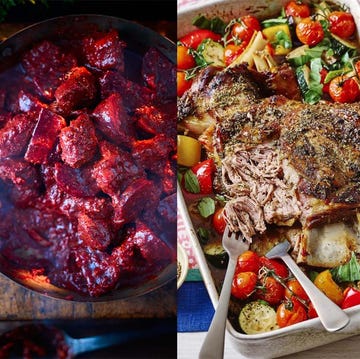Per serving (without mini eggs):
- Calories: 788
- Protein: 6g
- Total fat: 40g
- Saturates: 25g
- Carbs: 101g
- Total sugars: 79g
- Fibre: 1g
This is the prettiest Easter cake you'll see this year and makes the perfect baking project for the long weekend.

If you're planning on some serious baking over the Easter weekend, our impressive Easter cake, topped with mini eggs, has a light and fruity flavour that’s comparable to a Simnel cake, but the raisins are whizzed to a puree and added into the batter.
It’s perfect if you don’t like the texture of dried fruit, but still love the flavour that raisins give. You also don’t have to worry about the fruit sinking during baking either.
oil, to grease
raisins
unsalted butter, softened
light brown soft sugar
vanilla extract
mixed spice
finely grated zest 1 orange, plus 1tbsp juice
finely grated zest 1 lemon, plus 1tbsp juice
medium eggs
plain flour, sifted
baking powder
unsalted butter, softened
icing sugar, sifted, plus extra to dust
almond extract
3-5tbsp milk
yellow, green, blue, purple and pink
food colour paste/gels
mini chocolate eggs
Preheat oven to 180°C (160°C fan) mark 4. Lightly grease two 20.5cm round, loose-bottom cake tins, each about 9cm deep. Line bases and sides with baking parchment, making sure parchment is 4cm taller than sides of tins. Wrap outside of tins with a strip of newspaper, seven layers thick, secure in place with string and trim to same height as parchment.
To make cakes, in a small pan bring raisins and 175ml water to boil. Set aside. In a very large mixing bowl, using a handheld electric whisk, beat butter, brown sugar, vanilla, mixed spice and citrus zests until light and fluffy, about 5min. Beat in eggs one at a time. Beat in a little of the flour if mixture begins to curdle.
Whiz raisin mixture to a smooth purée in a food processor. Fold flour, baking powder, raisin mixture and citrus juices into butter mixture. Divide between prepared tins and smooth the tops. Bake for 1hr 25min-1hr 30min or until cakes are risen, springy to touch and a skewer inserted into the centre comes out clean. Cool completely in tins, covered with a clean tea towel.
If you do not have a large enough bowl, make buttercream in two batches. In a very large mixing bowl, beat butter with a handheld electric whisk until soft. Add half icing sugar and, starting slowly, beat to combine. Add remaining icing sugar and the almond extract and beat (slowly at first) until light and fluffy – about 3min. Beat in enough milk to make a thick but easily spreadable consistency.
Spoon 1.1kg buttercream into a separate bowl and set aside. Split remaining icing evenly among five bowls (weigh for best results, each about 250g). Dye each of these five icings to the desired shade using food gels, then spoon into five separate disposable piping bags.
Remove cakes from tins, peel o ff baking parchment and slice both in half horizontally with a serrated knife. Spread a little reserved plain buttercream on to a cake stand or plate. Using more plain icing, sandwich sliced cakes back together on stand/plate, making sure top layer is a cake base, cut-side down (this will ensure top of cake is smooth and flat). Use remaining plain buttercream to spread a generous layer on top of cake and a scant layer on sides. Chill for 20min.
Snip 1cm off end of each piping bag. Pipe a vertical line of seven dots on to side of cake, each about 2cm wide and 2cm deep, starting from the top and repeating the colours in the order: yellow, green, blue, purple, pink. Using a separate teaspoon for each colour, smear half of each icing dot on to cake in a horizontal line about 5cm long. On to smeared icing, pipe another row of vertical dots, starting at the top again with the next colour in the repeated series (eg, green). Smear as before, then repeat process starting with the third colour (blue), etc. The pattern will become apparent! Repeat piping and smearing until cake is covered. There will be a tiny gap where the final row of dots meets your first line of icing – make this the back of the cake.
Pile mini chocolate eggs on top of the cake and serve in slices.
GH TIPS:
If you want to get ahead you can prepare to the end of step 3 up to a day ahead. Once cool, remove from tins, wrap well in clingfilm and store at room temperature. Complete recipe to serve.
To store the finished cake, keep it in an airtight container (or loosely wrapped in foil) at room temperature for up to 2 days.
Extra fruity flavour? You can scatter a few extra raisins over the plain buttercream between each layer. Rather than the traditional marzipan top, we’ve opted for almond extract in the buttercream to create a similar flavour. If you aren’t a fan, you can use vanilla extract instead.
Don't be scared of the icing! All you have to do is pipe little blobs, then use the back of a teaspoon to squish them. This kind of decoration would make a beautiful birthday cake too. Make sure your buttercream is soft enough to spread and pipe.
Buttercream firmed up? Whisk in a few drops of hot water to soften it slightly.
A cake turntable and icing scraper or large palette knife are handy for getting a smooth, professional-looking finish to the coating on the top and sides. Although the sides will be hidden by the design, an even foundation makes the pattern pleasingly uniform.
This cake does require a fair bit of hands on time. To ease the load, you can make the sponges up to one day ahead, then ice the cake on the day of serving. For more Easter cake ideas check out our favourite Easter chocolate cakes including a giant chocolate cornflake cake and a no-bake chocolate cake.

Easy slow cooker leg of lamb recipe

Our best-ever carrot cake recipe

18 of our favourite slow-cooked lamb recipes

The ultimate leg of lamb recipe